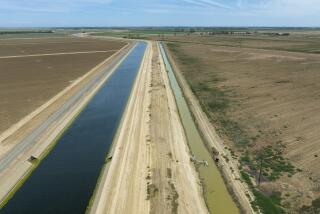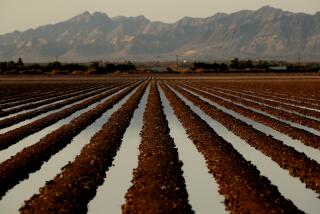WATER AND THE AMERICAN WEST : RIVERS OF EMPIRE:<i> Water, Aridity and the Growth of the American West by Donald Worster (Pantheon: $24.95; 402 pp.)</i> : CADILLAC DESERT:<i> The American West and its Disappearing Water by Marc P. Reisner (Viking: $19.95; 462 pp.)</i>
In a 1960 book, economist Jack Hirschleifer declared that the shortage of water in the United States was like the shortage of $500 Cadillacs. When price is kept artificially low, demand will naturally exceed available supply, whether an automobile or water is the object of desire.
In two remarkably comprehensive and well-written books, Donald Worster and Marc Reisner consider the role that water--especially artificially cheap water--has played in the development of the West. Both books are concerned primarily with federal water policy, particularly the role of the Bureau of Reclamation in water development, and both take strong issue with the dominant popular view of irrigation agriculture and its meaning for the West and for American society.
For most Americans, the term irrigation--like the term democracy--has both descriptive content as man-made technology for the application of water to agriculture and a value-laden content as the mastery of nature and the development of otherwise useless land for human economic purposes. It has had a positive valence for most Americans, and particularly for Westerners, because it arguably rendered an otherwise forbidding land not only livable but hospitable to the good life, providing millions with opportunity that would not have been available to them in the Eastern part of the country.
In challenging this perspective, both books have a strong historical orientation, describing the conditions that led to the passage of the Reclamation Act of 1902 and the consequences entrained by that legislation and its subsequent modifications. Both, for example, describe the exploits of John Wesley Powell and his epic expedition down the Colorado. Both describe events and forces that surrounded the passage of the Boulder Canyon Project Act and resulted in the construction of Hoover Dam and the canals that transported water to the Imperial Valley and to Southern California more generally. Both devote considerable space to descriptions and analyses of the conditions that led to the development of the State Water Project in California. From a thorough examination of the public record, both authors provide a wealth of detail as well as a comprehensive understanding of federal and regional water policy and its effects.
Their characterizations of federal water policy are somewhat different but perhaps in general terms, complementary. Worster’s analysis is derived explicitly but not uncritically from the writings of Karl Wittfogel, who first developed the concept of the hydraulic society, a society characterized not by freedom for the individual, or a broad sharing of whatever benefits accrue from irrigation, or a democratic process of decision-making with respect to its adoption, but rather by the imperial rule of a political/economic elite that gathers the benefits to itself and ensures virtual indentured service for those who make the enterprise profitable for that elite.
Drawing upon a vast historical record reaching back to early Egyptian and Chinese civilizations, Worster describes the development of the West in terms, first, of individual and group efforts at irrigation and, then, of more grandiose arrangements to promote irrigation through the use of the public treasury and the application of sophisticated engineering technology. He finds the seeds of empire in even the most local arrangements but its true florescence in the development of such schemes as the reclamation program of the national government. The record in the West, as Worster adduces it, is replete with evidence of empire by irrigation: the avarice of land promoters who saw gold in the water made available to the Salt River and Imperial Valleys; the pride of engineers who saw their technology as the salvation of the region; the self-interest of bureaucrats who sought larger budgets and of politicians out to feather their nests electorally. The result was highly integrated control systems for the management of water, heavily subsidized water projects benefiting largely corporate landowners, a dispossessed population of individuals and classes who labored with little reward, a powerful surge toward large-scale farming that drove the notion of the small independent farmer virtually out of the realm of possibility, and unsuspected but nevertheless ever-more-critical ecological problems
that may doom the entire Western enterprise to failure.
This is a brilliant book, clear in its argument, exceptional in its literary qualities. Worster is capable of making the most prosaic facts come alive through his mastery of the language, his imagery, and his ability to weave his ideas with events and personalities into a fascinating historical record.
Reisner, on the other hand, is less taken with explicit class analysis than he is with more detailed and perhaps somewhat more entertaining and anecdotal evidence of the wrongheadedness of federal water policy. He is less likely to characterize the Bureau of Reclamation as a tool for the ruling class than he is to view it as an institution with such professional and institutional arrogance that it fails to recognize the serious chinks in its engineering and economic capabilities. His accounts, for example, of the failure of the Teton Dam in Idaho and the bull-headed determination to construct the Narrows Dam in Colorado bespeak institutional failure of a monumental kind.
Reisner tells some fascinating stories and provides some invaluable character insights in understanding water politics. His story of the ravaging of the Owens Valley by the City of Los Angeles is not exactly new, in view of William Kahrl’s recent book on the subject, but it is a tale with a meaning, well told. His chapter on Floyd Dominy, the wily commissioner of the Bureau of Reclamation from 1959 to 1969, provides a remarkable insight into the power a bureaucrat can wield in the shark-infested waters of both Washington and regional politics.
Like Worster’s book, this is well-written history and analysis, thoroughly researched and abundantly clear in its message.
These books are not without limitations, however, as a part of the national history or as part of our thinking about irrigated agriculture in the West. As part of the national picture, the history of irrigation agriculture may not be as exceptional as the authors make it sound. They do not examine Eastern agriculture, but its history cannot be written without attention to engineering marvels--dams, levees, dikes, etc.--that have made lands productive for speculators at the expense of the taxpayers, often enough in rather hierarchically organized societies, particularly in the South. Neither author gives particular note to the enormous subsidies provided for protected industries in the East through the tariff and grants to railroads.
This raises the more general question about the influence of water management on society. Worster is careful to state explicitly his avoidance of single and simple explanations for the character of societies. And yet the very title of his book suggests that irrigation institutions are the reason why the West is not the place of freedom and independence that its admirers promote. It must be recognized, as Worster does, that Western society is largely an oasis society and that however free and independent its citizens are or are not, those qualities may have little to do with irrigation agriculture.
Even within irrigation agriculture, there is room to cavil a bit. While accepting the essential features of his principal story of nationalized irrigation, Worster’s own figures demonstrate an important fact: Most irrigation in the West is non-federal and even non-state. It is controlled by individual irrigators or small mutual companies who would find it ludicrous to describe their enterprises as parts of an empire.
In this respect, one must have some reservations about the characterizations of the Bureau of Reclamation as an agent of empire. While it occasionally must make hard bureaucratic decisions--as in cases of reallocations of water in droughts or dam releases in cases of flooding--its role has been one of accommodation of a multiplicity of local, congressional and institutional interests, largely for its bureaucratic survival.
As a story of interest to California, a couple of additional caveats may be registered regarding both books. First, there are differences in projects, especially in terms of their economics. One may attack the State Water Project as having questionable opportunity costs, but in levels of subsidization it is a wholly different animal from the Bureau of Reclamation’s Central Valley Project. Second, one must deal with the fact that Californians have rejected both the technological solution of the peripheral canal and the conservation solution of centralized control of Central Valley ground water. How those decisions fit these authors’ notions of democracy, economic efficiency and environmental protection is not clear.
Finally, one should note the authors’ concerns for the future in light of worsening water quality and increasing scarcity. Worster argues that Americans, Westerners in particular, must reject the role of authority over them with respect to water matters and must pursue a strategy leading to a “more open, free and democratic society.” We must respect the intrinsic qualities of rivers, reject domination of them, permit management to be in the hands of smaller, localized communities that would rely on their own capital and labor rather than on experts and their grand technologies; and we must divorce ourselves from world markets. The future, he argues, will be better for the lower classes if we do so, although worse for those who have dominated the “rivers of empire” in the past.
Reisner, consistently more concerned about the environment than about the class impact of irrigation agriculture, worries that the future will bring yet more audacious water development projects. Faced with siltation of dams, drying up of ground-water aquifers and salt accumulation on once-productive farmland, engineers and desperate communities may persuade politicians in both the United States and Canada that something like the North American Water and Power alliance should be revived to bring water from Northwestern Canada to many parts of the United States. It would be the biggest engineering project and the most disastrous of all time in terms of economics and the environment. God save us from such efforts to “save” irrigation agriculture.
What do these two books teach us? That it is usually bad politics and bad economics to deliver a commodity or service like water supply at less than its true social cost. Cheap water means benefits for a few who don’t need them and unintended consequences for the environment that can’t bear them.
More to Read
Sign up for Essential California
The most important California stories and recommendations in your inbox every morning.
You may occasionally receive promotional content from the Los Angeles Times.










